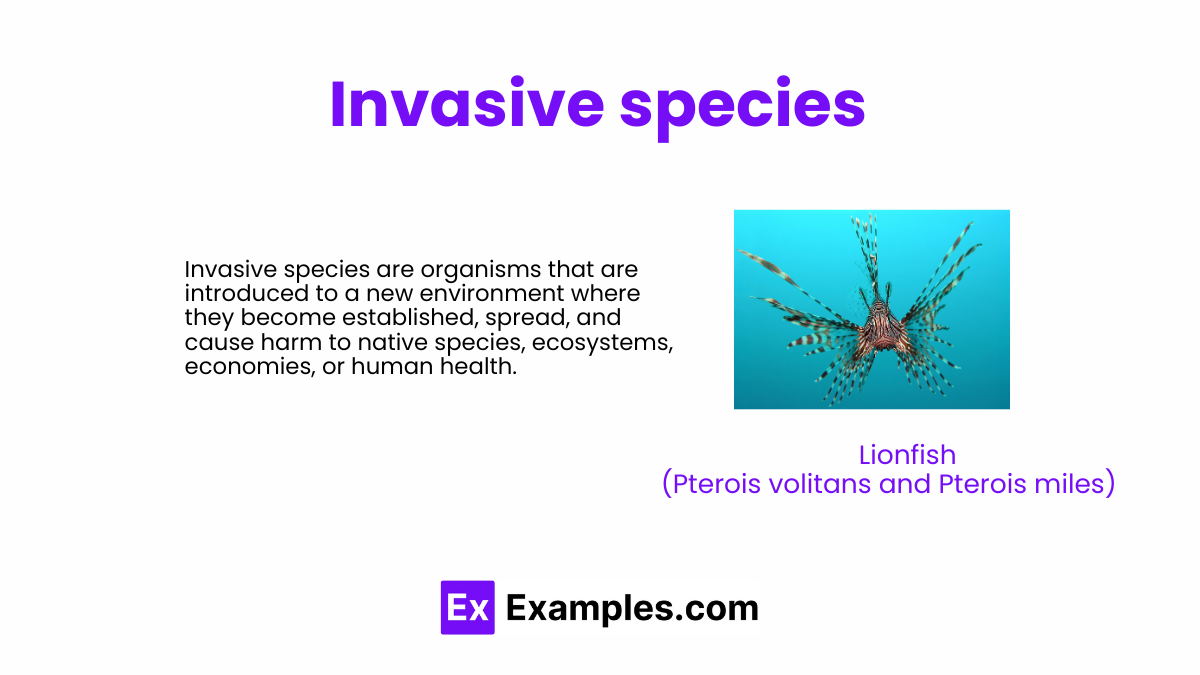What is an invasive species?
A native species
A species that has a stable population
A non-native species that causes harm to the environment, economy, or human health
A species that only lives in protected areas


Dive into the critical issue of invasive species with our comprehensive guide, where we unravel the complexities of non-native organisms that disrupt ecosystems worldwide. From the aggressive spread of the water hyacinth, Eichhornia crassipes, to the ecological challenges posed by the zebra mussel, Dreissena polymorpha, our guide illuminates the profound impacts these invaders have on biodiversity, habitat health, and local economies. Join us as we explore effective management strategies and the global fight to preserve natural habitats against these formidable foes.
What are Invasive Species?
Invasive species are organisms that have been introduced to an environment where they are not native, and once established, proliferate, spread, and cause significant damage to their new ecosystem. They can be plants, animals, fungi, or microorganisms. Their introduction into these new habitats often leads to environmental, economic, or health problems.
Invasive species are plants, animals, or pathogens that are not native to a specific location and have a tendency to spread, causing damage to the environment, human health, or the economy. Here are some key characteristics of invasive species:
Here are examples of invasive species across various categories, illustrating the diversity and global nature of the issue:
Invasive species spread through a variety of mechanisms, often facilitated by human activities as well as natural processes. Here are some key ways in which invasive species can spread:
Invasive species can have profound and varied impacts on ecosystems, economies, and human health. Their effects are often negative, leading to significant concerns and efforts to manage or mitigate their presence. Here are some of the key impacts of invasive species:
An invasive species is a plant, animal, or other organism that is not native to a specific location and causes harm to its new environment. It can affect native species, ecosystems, human health, and the economy.
Invasive species spread through various means, including international trade, transportation, landscaping, aquaculture, the pet trade, and natural dispersal mechanisms like water, wind, and animals. Human activities often play a significant role in their spread.
Invasive species can lead to loss of biodiversity, disrupt ecosystems and food webs, damage agriculture and infrastructure, impact human health through diseases and allergies, and lead to economic losses. They can alter habitats and reduce the effectiveness of natural resources.
Prevention includes implementing biosecurity measures, educating the public, regulating trade and transportation of species, managing ballast water on ships, and encouraging responsible pet ownership and gardening practices.
Control methods vary by species and include mechanical removal, chemical treatments, biological control (using natural predators or diseases), habitat restoration, and legislative actions to prevent introduction and spread.
While most invasive species are considered harmful, in rare cases, some may provide certain benefits, such as habitat for wildlife or erosion control. However, these benefits are often outweighed by the negative impacts.
Management involves coordinated efforts across governmental, non-profit, and community organizations. It includes monitoring, research, public education, physical removal, chemical treatment, and restoration of affected habitats.
Not all non-native species are invasive. A non-native species is one that is introduced into a new area, but it only becomes invasive if it spreads causing harm to the environment, economy, or human health.
The public can help by learning about and reporting sightings of invasive species, avoiding the release of non-native plants and animals into the wild, participating in local eradication efforts, and following guidelines to prevent the spread of invasive species during outdoor activities.
Yes, there are success stories where invasive species have been effectively controlled or eradicated, often through the use of integrated management approaches that include community involvement, biological control, and habitat restoration.
Invasive species pose significant threats to biodiversity, ecosystems, and economies worldwide. Their introduction, often by human activities, leads to competition with native species, habitat alteration, and sometimes, extinction of indigenous flora and fauna. Addressing this challenge requires comprehensive management strategies, international cooperation, and public awareness to mitigate impacts, preserve biodiversity, and protect vulnerable ecosystems from the irreversible consequences of invasive species.
Text prompt
Add Tone
How do Invasive Species Spread? briefly explain?
What are the Impacts of Invasive Species?
What is an invasive species?
A native species
A species that has a stable population
A non-native species that causes harm to the environment, economy, or human health
A species that only lives in protected areas
Which of the following is an example of an invasive plant species in the United States?
Oak tree
Japanese knotweed
Maple tree
Pine tree
How do invasive species typically spread to new areas?
Natural migration
Human activities such as trade and travel
Only through water
Only through air
Which of the following is a significant impact of invasive species?
Increased biodiversity
Improved soil fertility
Displacement of native species
Stabilized ecosystems
Which invasive animal species has significantly impacted the Great Lakes?
Zebra mussel
Bald eagle
Gray wolf
American bison
Why are invasive species often successful in new environments?
They have more predators in new environments.
They have fewer natural predators and competitors.
They reproduce slowly.
They rely on a single food source.
What is one common method to control invasive plant species?
Increasing irrigation
Mechanical removal
Planting more invasive species
Reducing sunlight exposure
Which of the following is an example of an invasive insect species?
Honeybee
Monarch butterfly
Asian long-horned beetle
Dragonfly
What effect do invasive species often have on local wildlife?
They provide additional food sources.
They increase genetic diversity.
They compete with and sometimes prey on local wildlife, leading to population declines.
They have no significant effect.
Which ecosystem is most vulnerable to invasive species?
Desert
Tropical rainforest
Island ecosystems
Tundra
Before you leave, take our quick quiz to enhance your learning!

